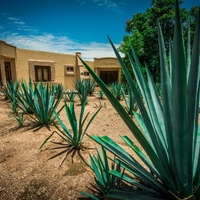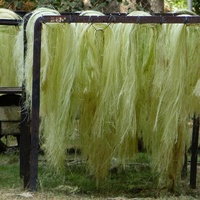Common name: Sisal
Other common names: Century plant, Mescal, Sisal agave, Sisal hemp
Description
Sisal is a succulent native to Mexico and valued for the long, strong fibres in its leaves.
Commonly 1 to 3 m (3 to 10 ft) tall, it develops a thick, stout central stem on which long fleshy sword-shaped leaves attach in an encircling arrangement. Individual leaves are up to 1.5 m (5 ft) long with smooth, dark to light green skin and a sharp, needle-like tip.
Flowering only once at the end of an eight-year lifespan, the plant grows a towering flower spike straight up from the centre of the plant, up to 7 m (23 ft) tall. At the top of the spike, bloom yellow-greenish flowers in the final spring to summer of the plant's life. Fruit rarely follow. Instead, numerous young plantlets, known as bulbils, usually grow to replace the flowers and are complete plants in themselves, able to be planted directly in the soil.
Use
A strong, highly tensile, durable fibre stripped from the leaf has many industrial uses. These include the manufacture of carpet, carpet backing, rugs, rope, cordage, wash and cleaning cloths, large bags or sacks (such as coffee sacks), wall plaster reinforcement material, composite materials (such as composites of fibre and plastic), material for replacing fibreglass in moulded products, as well as speciality pulps for the manufacture of durable paper products such as coffee filters and banknotes. Paper products manufactured using Sisal are reported to have an exceptionally high tear strength.
The leaves can be harvested year-round but are usually harvested periodically, on average around twenty times over the plant's life, beginning when the plant is around two to three years old. The raw fibres are stripped from the leaves, washed and dried in the sun. The sun-dried fibres then undergo further refinement, including brushing to ready them for manufacturing.
The flowers produce nectar in such abundance that it drips onto the leaves. Honey made from it is dark and intense but of poor flavour and is generally unpalatable. However, it is of good energy value to brood-rearing honeybees.
The dried, skeletonised leaves are used as a textural component in floral arrangements.
It is sometimes cultivated as an ornamental in gardens for its handsome shape and sharp thorns, which serve as a barrier to unwelcome visitors.
Climate
Sisal grows naturally in sub-humid to moderately humid subtropical and tropical climates, generally areas with annual lows of 12 to 25°C, annual highs of 24 to 36°C, annual rainfall of 500 to 1400 mm and a dry season of 4 to 9 months.
Growing
New plants are usually grown from plantlets taken from the flower spike. Still, suckers borne from around the base of mature plants are also considered suitable planting material.
Sisal performs best on free-draining sand or loam soils with a slightly acid to alkaline nature, generally with a pH of 6.0 to 8.5, and on sites with full sun exposure. It is intolerant of waterlogging.
Problem features
It produces hundreds of plantlets that eventually fall from the flower spike to the ground, where some take root, creating new plants that can form dense, impenetrable thickets over successive generations.
It is listed as a weed in more than one reference publication and is assessed to be a high weed risk species for Hawaii by the Hawaii Pacific Weed Risk Assessment project (HPWRA)
The sap from the leaves is an irritant and can cause contact dermatitis and swelling of the mouth and throat tissues. The sharp, needle-like spine at the end of the leaf can cause serious injury.
Where it grows
References
Books
-
Adams, C. D. 1972, Flowering plants of Jamaica, University of the West Indies, Mona, Greater Kingston
-
Dastur, J. F. 1964, Useful plants of India and Pakistan : a popular handbook of trees and plants of industrial, economic, and commercial utility, 2nd ed., D. B. Taraporevala Sons, Bombay
-
Dewey, L. H. 1943, Fiber production in the western hemisphere, U. S. Department of Agriculture (USDA), Washington D.C.
-
Duke, J.A. 1993, CRC Handbook of Alternative Cash Crops, CRC Press, Boca Raton, Florida
-
Gilbert, V., Smith, S. & Young, L. 2006, Foliage for florists, Society of Floristry, United Kingdom
-
Litzenberger, S. C. 1974, Guide for field crops in the tropics and the subtropics, Office of Agriculture, Technical Assistance Bureau, Agency for International Development (USAID), Washington D.C.
-
Perkins, K. D. & Payne, W. 1981, Guide to the poisonous and irritant plants of Florida, Florida Cooperative Extension Service, Gainesville, Florida
-
Purseglove, J. W. 1981, Tropical crops: Monocotyledons, Longman, Harlow, London
-
Randall, R. P. 2002, A global compendium of weeds, R.G. and F.J. Richardson Press, Melbourne
-
Randall, R. P. 2007, The introduced flora of Australia and its weed status, Cooperative Research Centre for Australian Weed Management, Glen Osmond, South Australia
-
Smith, F. G. 2003, Beekeeping in the tropics, Northern Bee Books, Hebden Bridge, West Yorkshire
-
Wood, I. M. 1997, Fibre crops : new opportunities for Australian agriculture, Queensland Department of Primary Industries (QLD DPI), Brisbane
Articles, Journals, Reports and Working Papers
-
Morton, J.F. 1964, Honeybee Plants of South Florida, Proceedings of the Florida State Horticultural Society, Vol 77:415-436.



